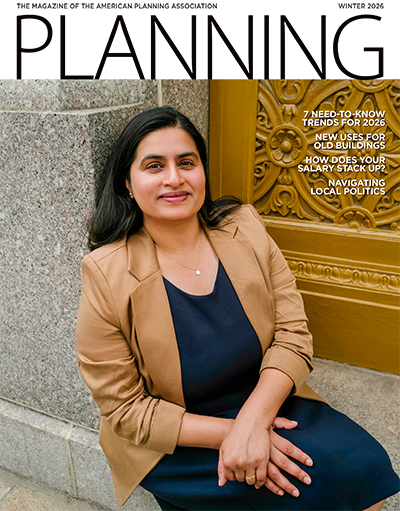March 21, 2024
This story is part of the "Tech Tools" series, created in collaboration with APA's Technology Division. From climate resilience to mobility to tools that help make critical decisions on affordable housing, we highlight topical datasets, applications, and other tools that help planners understand — and better plan for — their communities.
Digital twins are increasingly being discussed in planning as the ultimate scenario planning tools, where physical components of our world are intertwined with simulations and data feeds that enable communities to understand the ripple effects of planning actions. We have seen stunning examples from different communities using these tools to chart their futures or examine development impacts. But connecting all the systems and data to build digital twins can feel daunting. Plus, a community is far more than its data and physical assets; it is fundamentally defined by the people within it and their collective choices.
Resources to create digital twins
This technology can expand planning practice through integrating diverse datasets — geospatial data, detailed 3D models, and physical world captures — to depict both the built environment and the communities that inhabit them. The datasets that help build that comprehensive understanding come from a variety of different sources, including public or private data providers and data collected by planners themselves. While a digital twin is by no means a 100 percent solution, it does augment planners' understanding of spatial issues.
In this article, we will explore some of the datasets that can be used to create a digital twin.

A comparison of NOAA's historical 30-meter resolution and Ecopia AI-provided 1-meter resolution data and high-resolution vector base product in Charleston County, South Carolina. Graphics courtesy of Ecopia AI.
Ecopia AI
Data
Ecopia AI leverages advances in computer vision to convert high-resolution images into high-definition vector maps of land cover and infrastructure assets in a geospatial format. While remotely sensed data depends on the quality of the imagery and visibility of assets, it provides a scalable and cost-effective licensed data source. Its data is also increasingly being used to improve the resilience of coastal communities by improving on traditional land cover classification methods. Ecopia AI leveraged its technology to produce high-resolution vector data globally at 30-centimeter resolution, a significant improvement over the traditional 10- to 30-meter resolution from similar derivative products. Its innovative approach has led to the production of high-quality datasets at costs similar to less detailed products, supporting the National Oceanic and Atmospheric Administration's (NOAA) Digital Coast program by transforming national vector land cover data into 1-meter raster formats.
Cost: Paid (licensed data product)
Resource formats: Geospatial data
Coding skills required: No

A sidewalk accessibility and connectivity analysis was completed through GeoMate's AI mapping solution in Mountain View, California. Graphic courtesy of GeoMate.
GeoMate
Data
GeoMate, a startup and Esri Partner, provides high-definition vector maps from high-resolution aerial imagery to support autonomous vehicles and urban planning use cases. Like Ecopia AI, GeoMate's advanced remote sensing techniques have similar limitations and data-licensing considerations for practitioners to consider, but they focus on enabling a human-centric approach to data acquisition and cataloging to ensure municipalities can create environments suitable for all forms of transportation. In collaboration with the city of Mountain View, California, GeoMate mapped sidewalk networks and active transportation connectivity to meet Americans with Disabilities Act (ADA) standards. They provided precise data on sidewalk locations, crosswalks, slopes, and geometry, aiding the city in prioritizing sidewalk improvements. This data ensured ADA compliance, improved pedestrian safety, and fostered inclusive urban environments.
Cost: Paid (licensed data product)
Resource formats: Geospatial
Coding skills required: No

The Hollywood Chamber of Commerce leveraged CyberCity 3D to contextualize development projects within the neighborhood. Graphic courtesy of CyberCity 3D.
CyberCity 3D
Data | 3D Modeling
CyberCity 3D is a 3D data provider specializing in transforming stereo imagery and point clouds into high-resolution building models. It has provided digital city models in a large variety of formats for government, planning agencies, architects, commercial real estate, and more. The program can provide a variety of output models ranging from planimetric building footprints to attributed digital models and photorealistic textured models. For example, the Hollywood Chamber of Commerce in Los Angeles leveraged CyberCity 3D buildings to create a user-friendly web application that meets the needs of its members and stakeholders. By digitizing the economic development map, the chamber seeks to provide a modern and efficient tool for accessing vital information about development projects in the Hollywood area.
Cost: Paid
Resource formats: Geospatial, 3D models formats (multiple)
Coding skills required: No

RealityScan guides smartphone users to collect photos that can be used to create realistic 3D models through photogrammetry. Image courtesy of Epic Games.
RealityScan and RealityCapture
Data | Reality Capture| 3D Modeling | Visualizer
Part of the Unreal Engine ecosystem, RealityCapture and RealityScan collaboratively offer a robust solution for digitizing the built environment. RealityScan, a user-friendly mobile app, facilitates image capturing directly from smartphones. Scans are uploaded to Sketchfab where they can be downloaded and incorporated into 3D modeling software like Unreal Engine. RealityCapture automates the photogrammetry process to transform photos and laser scans into precise 3D models. This combination not only empowers communities to create detailed digital representations of their spaces but also allows for the integration of these 3D models into modeling and GeoBIM software like Twinmotion, Unreal Engine, Cesium, and Esri, enhancing urban planning, preservation, and development projects with immersive, accurate models and visualizations.
Cost: Paid
Resource formats: Mobile, computer
Coding skills required: No




